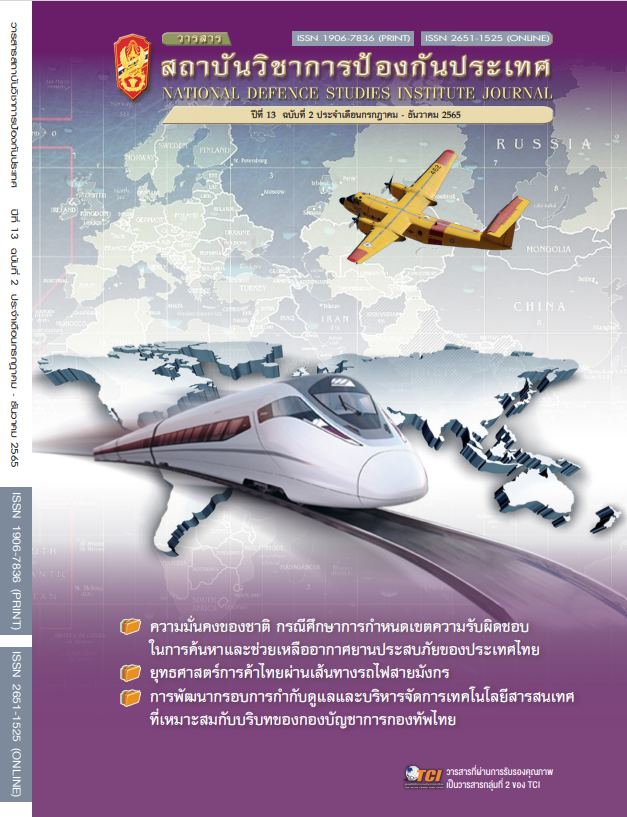Analyzing the Amount of Metal in Glycerin from the Acid-Catalyzed Solvent Extraction Process Cooperating with a Rotary Evaporator
Main Article Content
Abstract
Biodiesel can be used as a renewable energy in biodiesel production, crude glycerin is always a by-product. So, if we are able to increase the value of such crude glycerin, the cost of the biodiesel production process will be cheaper. Besides the percentage of glycerin purity, the percent of contaminated metal in the extracted glycerin is also important. If the extracted glycerin has a high percent of purity and a high percent of contaminated metal, the extracted glycerin cannot be used as a reactant in many industries. Therefore, the purpose of the research is to study the metal content of potassium (K), sodium (Na), iron (Fe) and lead (Pb) in crude glycerin before and after the extraction process using 8 M sulfuric acid. and 8 M phosphoric acid in combination with a rotary evaporator.
From the result, crude glycerin, a by-product of biodiesel production from using oil, contained potassium (K) 3.2%, sodium (Na) 0.02%, iron (Fe) 29.4 mg/kg and lead (Pb) less than 2.5 mg/kg According to the research results, the extracted glycerin by using sulfuric acid 8M had 89.7 ± 0.01% of the purity with potassium (K) 0.03%, sodium (Na) 0.002%, iron (Fe) 2.8 mg/kg and lead (Pb) less than 2.0 mg/kg while the extracted glycerin by using phosphoric acid 8 M had 87.7 ± 0.01% of the purity with potassium (K) 0.04%, sodium (Na) 0.004%, iron (Fe) less than 2.5 mg/kg and lead (Pb) less than 2.0 mg/kg, respectively. The amount of contaminated metal had been reduced significantly and the number of heavy metals is in accordance under the standards of the Ministry of Industry. Therefore, the extraction of glycerin by this method will help to reduce the cost of biodiesel production and encourage communities to be more interested in biodiesel production which will make the energy sustainable in the community and the nation.
Article Details

This work is licensed under a Creative Commons Attribution-NonCommercial-NoDerivatives 4.0 International License.
The articles, images, tables, graphs, written content, and opinions published in this journal are solely those of the authors and do not necessarily reflect the views or positions of the National Defence Studies Institute or its academic affiliates.
References
จารุวรรณ ดรเถื่อน และกนกอร นักบุญ. (2561). การหาปริมาณเมทานอลและโลหะหนักบางชนิดในไวท์เม่า. วารสารวิทยาศาสตร์เกษตร, 48(1 พิเศษ), 625-628.
“ประกาศกระทรวงสาธารณสุข เรื่อง ชื่อวัตถุที่หามใช้เป็นส่วนผสมในการผลิตเครื่องสำอาง พ.ศ.2559” (2559, 17 พฤษภาคม). ราชกิจจานุเบกษา. เล่ม 133 ตอนพิเศษ 114 ง.
ปวีณา พาณิชยพิเชฐ. (2563). ลดโลกร้อนด้วย zero waste. สืบค้นจาก https://ghgreduction.tgo.or.th/th/download-tver/68-tver-publications/1384-zero-waste.html
Attard, T., & Attard, E. (2022). Heavy Metals in Cosmetics. In Seleh, H. M., & Hassan, A. I. (Eds.), Environmental Impact and Remediation of Heavy Metals. London: IntechOpen Limited.
Bagnato, G., Iulianelli, A., Sanna, A., & Basile, A. (2017) Glycerol production and transformation: A critical review with particular emphasis on glycerol reforming reaction for producing hydrogen in conventional and membrane reactors. Membrane, 7(2).
Favier, I., Pla, D., & Gomer, M. (2018). Metal-based nanoparticles dispersed in glycerol: An efficient approach for catalysis. Catalysis Today, 310, 98-106.
Muniru, O. S., Ezeanyanaso, C. S., Fagbemigun T. K., Akubueze E. U., Oyewole O. A., Okunola O. J.,...Elemo G. N. (2016). Valorization of Biodiesel Production: Focus on Crude Glycerine Refining/Purification. Vth International Symposium on Fusion of Science & Technology (p.293-397). New Delhi.
Pal, P. & Chaurasia, S. P. (2016). Characterization of Crude and Purified Glycerol from Biodiesel Production and Purification Techniques. Vth International Symposium on “Fusion of Science & Technology (p.293-397). New Delhi.
Satachon, P., Keawmoon, S., Rengsungnoen, P., Thummajitsakul, S., & Silprasit, K. (2019). Source and Health Risk Assessment of Heavy Metals in Non-Certified Organic Rice Farming at Nakhon Nayok Province, Thailand. Applied Environmental Research, 41(3), 96-106.


